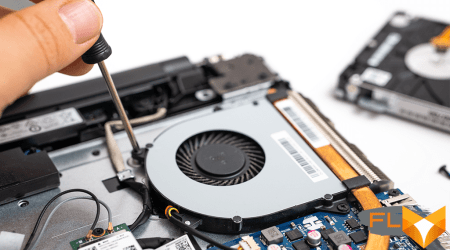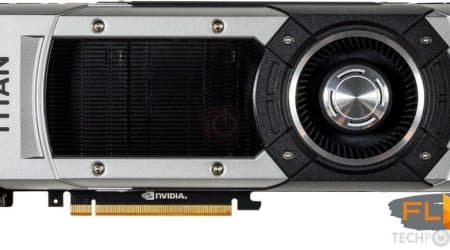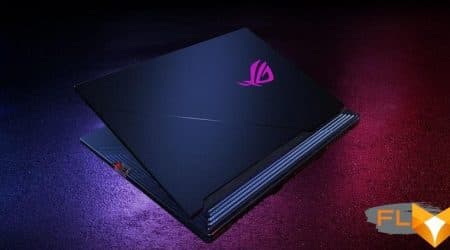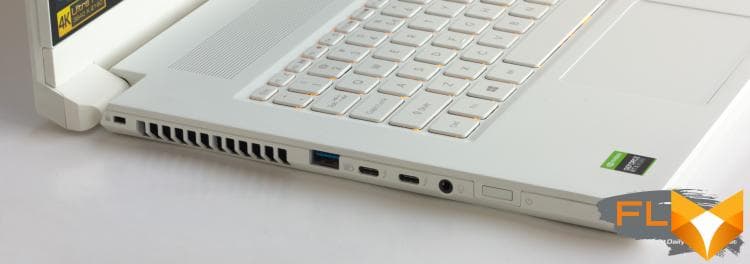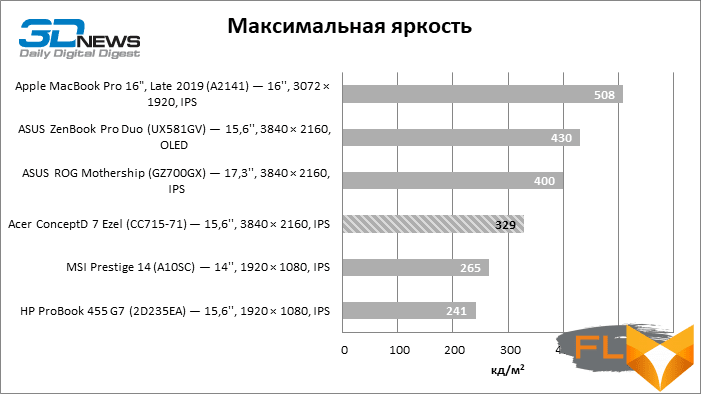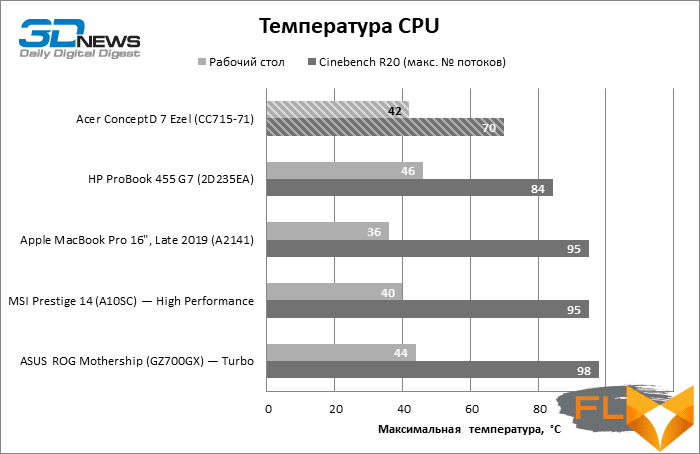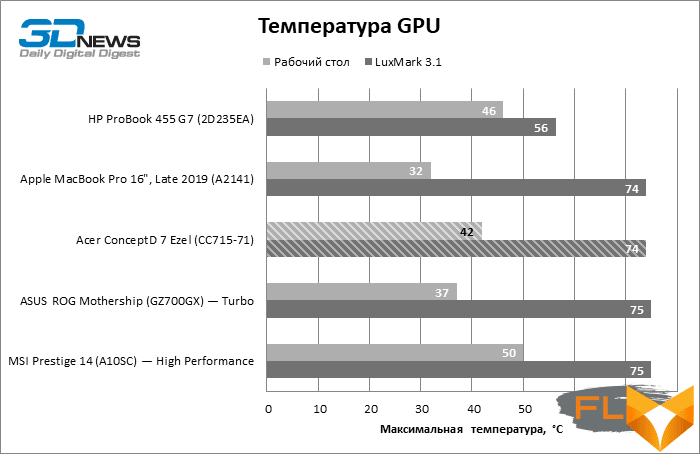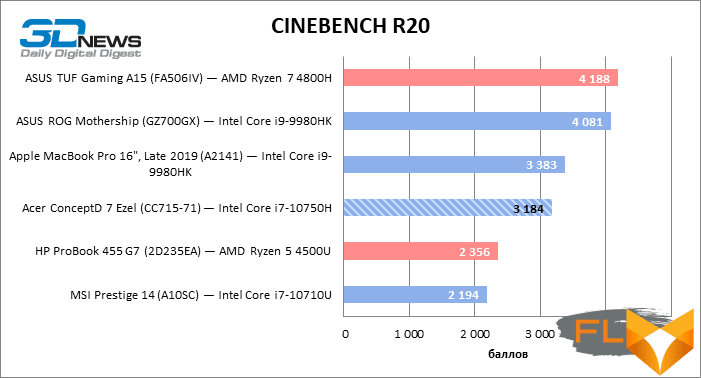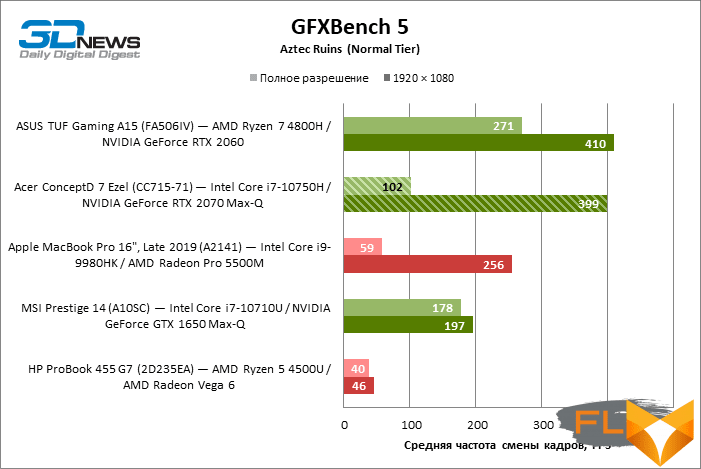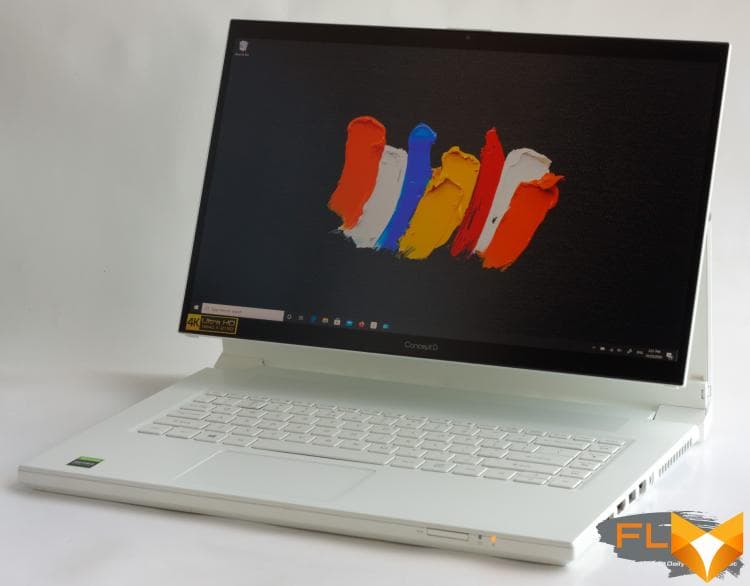


Thanks to the achievements of the semiconductor industry over the past few years, a high-performance laptop is quite capable of replacing a stationary PC in tasks such as video editing, CAD and other areas of professional visualization. Of course, adjusted for the scale of work, in many cases a desktop armed with dozens of CPU cores and hundreds of megabytes of RAM is still indispensable.
However, almost every laptop with a discrete video adapter and a more or less high-quality screen matrix now claims the laurels of a workstation, which is quite true when it comes to photo processing, but for more demanding tasks you need more powerful hardware. And most importantly, not all mobile PCs meet the high requirements for ergonomics, build quality and expandability that a buyer is entitled to present in search of an expensive tool for daily professional activities. Not to mention specific features, whether it’s a Wacom digitizer screen instead of a regular touchscreen, or a GPU optimized for CAD packages.
Acer is known to readers primarily as a manufacturer of ultrabooks and gaming PCs, but recently the Taiwanese company has been trying its hand at the portable workstation market. We can assure you that this title definitely applies to the ConceptD 7 Ezel laptop without any reservations.
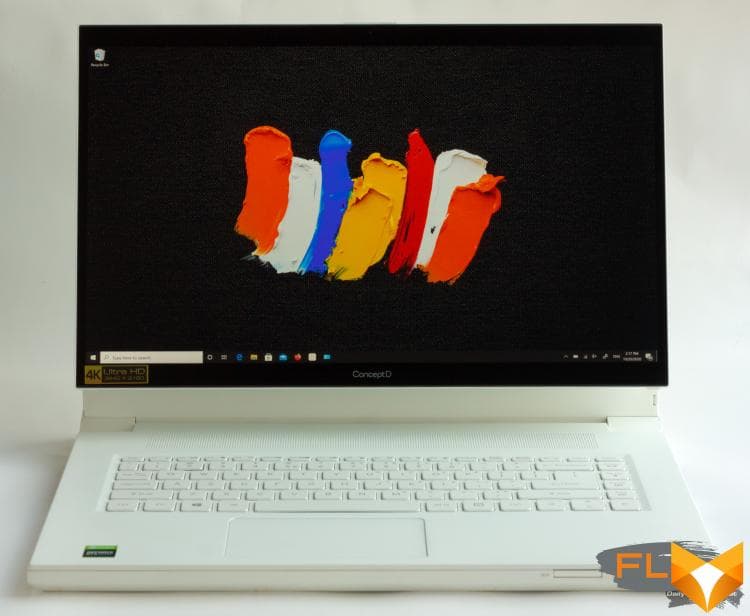
Specifications, prices
Starting to review the next Acer laptop, we again have to complain that the company does not indicate on the website all the varieties of the device that it produces. However, the scatter of components in this case may not be as wide as in consumer models, and the supply of the ConceptD 7 Ezel on the Internet marketplaces is very limited, so we seem to have been able to quite accurately delineate the range of possible Acer mobile workstation configurations.
The Taiwanese have transferred their ConceptD series of mobile PCs for professionals to the fresh Intel Comet Lake platform, in the maximum configuration it uses an eight-core Core i7-10875H chip. The official website gives the impression that simpler versions of the ConceptD 7 Ezel do not exist, but viewing the price lists and the very existence of a sample machine refutes this information.We got a laptop with a six-core CPU Core i7-10750H. From the reader’s row comes an exclamation of disappointment: “Why not Ryzen?” Indeed, the outstanding energy efficiency of the “red” 4000-series processors is a silent reproach to all mobile computers based on the Intel platform, no matter how wonderful they may be in all other respects. However, it is in the case of the ConceptD 7 Ezel that loyalty to Intel products is justified by the purpose of the device. The scope of such laptops includes not only artistic design, video and photo processing, but also CAD tools, which, due to their architecture, require high single-threaded performance. And this is still the strength of the “blue” chips. Also part of the Intel ecosystem is the Thunderbolt interface, which is most often idle in consumer computers, but is widely used by professional equipment.
But the issue of choosing discrete graphics for the ConceptD 7 Ezel was resolved in advance in favor of NVIDIA processors, since AMD seems to have finally lost ground in the professional visualization market and things are not going well with software support for RDNA chips in the corresponding software. The ConceptD 7 Ezel specifications assume the installation of GeForce RTX 2070 and RTX 2080 SUPER discrete video adapters. Moreover, judging by the test sample, the RTX 2070 is made in the Max-Q design, that is, with a limited thermal package. The same probably applies to the older version. As part of the ultimate configuration, Acer offers the Quadro RTX 3000 accelerator. Note that the latter is based on the same TU106 GPU as the GeForce RTX 2070, but has only 6, not 8 GB of dedicated memory. Lack of VRAM will be an obstacle for editing ultra-high resolution video or rendering complex 3D models, but Quadro has specific optimizations aimed at improving the performance of CAD packages.
| Manufacturer | Acer |
|---|---|
| Model | ConceptD 7 Ezel |
| Display | 15.6”, 3840 × 2160, IPS, touch |
| CPU | Intel Core i7-10750H (6/12 cores/threads, 2.6-5.0 GHz); Intel Core i7-10875H (8/16 cores/threads, 2.3-5.1 GHz) |
| RAM | DDR4 SDRAM, 2633 MHz, 16/32 GB (two channels) |
| GPU | NVIDIA GeForce RTX 2070 Max-Q (8GB GDDR6); NVIDIA GeForce RTX 2080 SUPER (Max-Q ?) (8 GB GDDR6); NVIDIA Quadro RTX 3000 (6GB GDDR6) |
| Drive | SSD (PCI Express 3.0 x4) 1024 GB |
| External I/O connectors | 2 × Thunderbolt 3 / USB 3.2 Gen 2 Type-C; 2 x USB 3.1 Gen 1 Type-A; 1 x DisplayPort; 1 x HDMI; 1 × Gigabit Ethernet; 1 x SD; 1 × TRS 3.5mm |
| Network | IEEE 802.11ax + Bluetooth 5.0 |
| Battery capacity, Wh | 84 Wh |
| Weight, kg | 2.5 kg |
| Overall dimensions (L × H × D), mm | 358.5 x 260 x 28.6 |
| Retail price, USD | From 4300 (Core i7-10750H, 32GB, Quadro RTX 3000, 1024GB SSD) |
The system memory of the laptop is 16 or 32 GB DDR4, and the amount of ROM is up to 2 TB. By the way, the terabyte drive in our ConceptD 7 Ezel sample is built from two SSDs in RAID 0 mode. And if a zero array does not offer any tangible benefits in consumer PCs (in our opinion, it rather harms the average user, since it increases the risk of data loss), then when working with professional software, the bandwidth of the ROM may well be a bottleneck.
Finally, the ConceptD 7 Ezel features a luxurious 15.6-inch 4K display with full Adobe RGB coverage and Delta E hardware calibration.
Readers probably guessed that all this splendor costs far from small money. Indeed, the cheapest laptop modification we could find sells for almost $4,300. And this is far from the limit! There are similar machines in Acer’s catalog under the ConceptD 7 Ezel Pro brand, which differ from the usual models in this series with Intel Xeon processors, ECC-enabled RAM and a graphics card repertoire that crowns the Quadro RTX 5000.
If you evaluate laptops only by the list of main components, among the gaming models there are a lot of similar devices that cost much less. Or vice versa, for the same money it is easy to choose a more powerful computer. But the ConceptD 7 Ezel is not designed for gaming at all, and gaming laptops lack the features that the ConceptD 7 Ezel has, and, to be honest, most of them are not made so well.
⇡#Look and Ergonomics
The ConceptD 7 Ezel is another take on a convertible laptop, which in itself is no surprise. However, Acer has come up with an ingenious approach to a design problem that doesn’t seem to have a perfect solution. Most convertible devices on the market enter tablet mode when the screen cover is flipped 360° and the keyboard and touchpad topcase is at the bottom. This is a simple, not very elegant way, but the common alternative is hardly better in terms of chassis mechanics. In other transformers, the cover rotates around a vertical axis or around a horizontal one, but for this you have to surround the screen with a fixed support (as Acer used to do). In both cases, the design becomes more complicated and loses its strength, besides, it is more difficult for the manufacturer to maintain the maximum ratio between the area of the screen matrix and the frames. Finally, there are 2-in-1 computers, the main filling of which is tied to the screen, and the keyboard simply comes unfastened, but this imposes strict restrictions on power consumption and performance of components.

The ConceptD 7 Ezel is completely different. The screen cover is made in two parts so that the screen is suspended on its own leg – similar to the two-stage hinge of the Microsoft Surface desktop or the Apple Pro Display XDR monitor. And in the standard position, only the hinge on the back of the display makes it clear that the ConceptD 7 Ezel is a convertible laptop. It is easy to open with one hand and the lid halves do not come apart because they are held together by strong magnets. But then the screen can be brought closer to the eyes, rotated 180 °, or turned into a weighty tablet out of a laptop. Yes, the ConceptD 7 Ezel is not a feather, the novelty pulls 2.5 kg.

At the same time, the case in any configuration rests on the table with the protrusions of the bottom panel, and nothing interferes with the operation of the cooling system. We can’t vouch for longevity, but the hinge mechanics on our ConceptD 7 Ezel sample seem to be exceptionally reliable. Each turn requires effort – not too much to cause discomfort, but enough to keep the screen in the chosen position and not wobble.
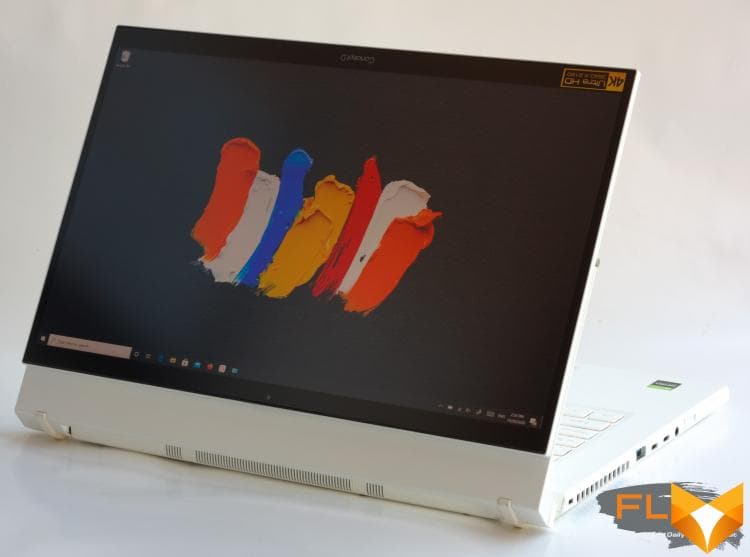
Of course, Acer went for such tricks for a reason, but because the laptop screen boasts not only high resolution and extended color gamut, but also a touch surface. Moreover, in the interface of the OS and applications, you can use both fingers and a complete stylus with Wacom EMR technology, which recognizes 4096 degrees of pressure. The pen with two auxiliary buttons is a passive device that does not require charging and works in the same way as all such manipulators, that is, when the tip hangs above the screen surface, it is followed by a cursor. For storage of the stylus, there is a slot in the screen cover. By the way, here’s a nuance that emphasizes the attention to detail in the design of the novelty: the stylus can be hooked up and removed from the slot only when the laptop is open, that is, it will definitely not be lost during transportation.
It’s hard for a non-artist to appreciate this tool, but what definitely wouldn’t hurt the ConceptD 7 Ezel’s screen is a higher refresh rate than the standard 60Hz to eliminate the lag between pen movement and the image. Alas, it seems that these are too high requests for an already excellent matrix. By the way, unlike many transformers, the Acer laptop screen is not glossy, but covered with an anti-reflective film, which makes it easier to work in bright light.

However, the ConceptD 7 Ezel is primarily a laptop, not a tablet, albeit with advanced “creative” functions, so let’s turn our attention to the standard controls. But let’s start from afar. The main thing that determines whether it is convenient to use the keyboard (and not only for shortcuts in applications, but for typing) is not the key mechanism at all, but the chassis materials and the layout of internal components. The snow-white color and angular retro-futuristic design suggest that the laptop case panels are made of plastic. It is actually a magnesium-aluminum alloy with a special ceramic-like coating that protects the surface from scratches.
Internal struts and, not least, a massive cooling system, gave the structure enough rigidity so that the keyboard and touchpad lay on a solid (though, alas, not as “reinforced concrete” as, for example, in “Macbooks”) base, and this already half the battle. However, Acer still lacks the experience to compete with the best in the industry in terms of keyboard quality. So, the moment of operation could be more distinct, and the return to neutral position faster. Besides, markings are always less noticeable on white keys (however, the backlighting here is amber, and this partially solves the problem). However, against the background of the mediocre quality of this component in most laptops, including those that cost no less than the ConceptD 7 Ezel, its keyboard stands out for the better and has not spoiled the extremely positive impressions of the device so far.
The same can be said about the touchpad. It is covered with glass that is smooth to the touch, perfectly tuned and pressed through with a confident click without extraneous overtones. My only gripe is that the panel is quite small by today’s standards, since its area had to be sacrificed for the ventilation grille between the keyboard and the screen.
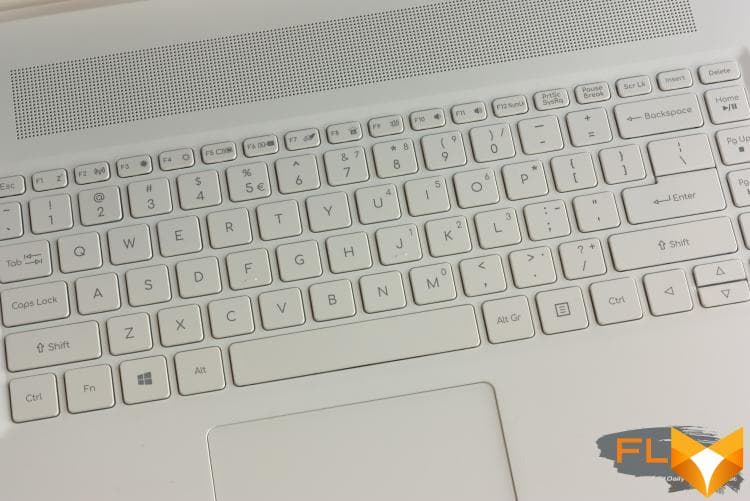
Another important advantage of the Acer workstation is the variety of wired communications. While the Thunderbolt interface and USB of the latest revisions tend to absorb all formally obsolete standards, Acer paid tribute to the requirements of the times – there are two Thunderbolt 3 connectors on board the laptop, but at the same time found a place for two USB 3.1 Gen 1 Type-A ports, wired network, HDMI, and even full-sized DisplayPort. The latter is already extremely rare in laptops. On the front side of the case there is a slot for an SD card reader, covered with a plug, and a full-size one.
A modern business-class laptop or mobile workstation is hard to imagine without biometric identification tools, but the ConceptD 7 Ezel does not have a separate fingerprint scanner: it (hooray!) Is integrated into the power button on its side.
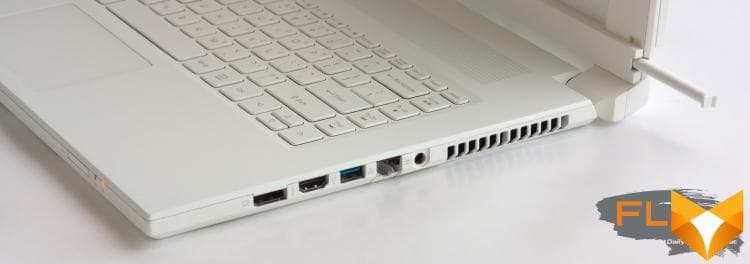
The CPU and GPU in the ConceptD 7 Ezel configuration that we received for testing consume up to 125W in total, which is not the most fancy configuration of the novelty. As a result, you can forget about the possibility of power over the Thunderbolt 3 cable, which is rated for no more than 100 watts of power. The laptop is connected to the power supply – admittedly quite compact and light for the 180 W rating – with a standard barrel plug.
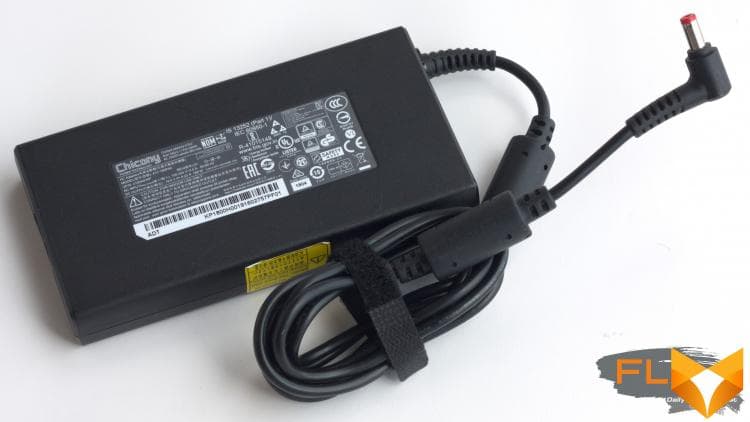
⇡#Internal arrangement and upgrade options
The ConceptD 7 Ezel’s cooling system is designed so that air enters through a large grill at the bottom of the case and exits out the sides of the keyboard. In the working position with the lid up, the laptop rests on the protrusions of the screen hinge, but both in tablet mode and in closed mode, when using an external monitor, there is a fairly large distance between the grill and the table. As a result of this design, it is not recommended to keep the computer on your knees during an intensive computing load, but the cooler has a kind of safety mechanism: part of the air enters the turbines not only from below, but also from above, through a network of holes between the keyboard and display.
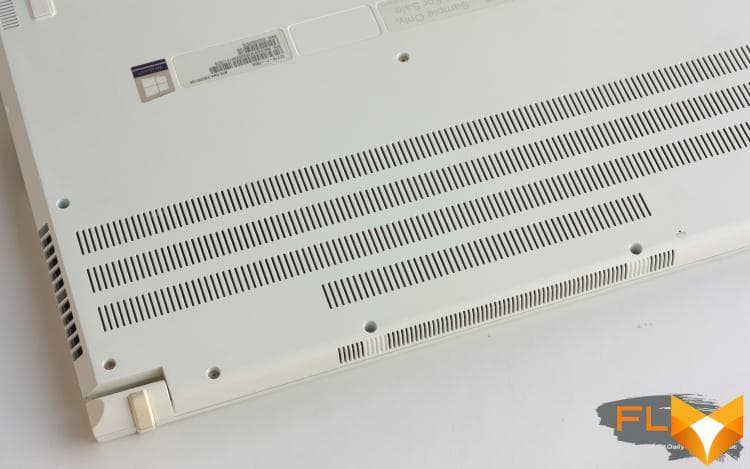
Another little thing to thank the Acer engineers for is how easy it is to open the computer for dusting and upgrading. It often happens that after removing the screws that hold the case panels, you have to meticulously disconnect the latches around the perimeter or simply rip the pallet from its place, risking damage to the fasteners. The bottom panel of the ConceptD 7 Ezel is simply pry off with a fingernail and then removed with a little effort.
Inside, the user will see an impressive cooling system with two heat sinks that completely cover not only the CPU and GPU crystals, but also the video memory and VRM keys of both chips. The RAM here is not soldered to the motherboard and allows a painless upgrade, as well as two solid-state drives under their own copper radiators. Perhaps the only flaw in the design of the ConceptD 7 Ezel is that there was no room inside the rather spacious chassis for a battery more capacious than 84 Wh, while manufacturers of more compact machines are held back only by the 100 Wh limit set by for transportation in the cabin of an airliner.

⇡#Test Methodology
| Synthetic tests | |
|---|---|
| Application | Settings |
| 3DMark Time Spy | — |
| Geekbench 4 | — |
| CINEBENCH R20 | — |
| GFXBench 5 (Aztec Ruins — Normal Tier, High Tier) | Windows: Vulkan, macOS: Metal |
| fio 3.16 | Sequential read/write, random read/write (unbuffered I/O) |
| Work Applications | |||||
|---|---|---|---|---|---|
| Application | Benchmark | Settings | API | ||
| Intel Graphics | AMD Graphics | NVIDIA Graphics | |||
| Adobe After Effects CC 2019 | PugetBench for Afer Effects 0.82 (linked test structure) | — | OpenCL (Windows)/Metal (macOS) | OpenCL (Windows)/Metal (macOS) | CUDA |
| Adobe Photoshop CC 2019 | PugetBench for Photoshop CC 0.8 (linked test structure) | Basic Benchmark | OpenGL + OpenCL + Metal (macOS) | OpenGL + OpenCL + Metal (macOS) | OpenGL + OpenCL |
| Adobe Photoshop Lightroom Classic CC 2020 | PugetBench for Lightroom Classic 0.8 (test structure at link) | — | DirectX 12 (Windows) | DirectX 12 (Windows) | DirectX 12 |
| Adobe Premiere Pro CC 2019 | PugetBench for Premiere Pro 0.8 (linked test structure) | Standard Benchmark | OpenCL (Windows)/Metal (macOS) | OpenCL (Windows)/Metal (macOS) | CUDA |
| Blackmagic Design DaVinci Resolve Studio 16 | Puget Systems DaVinci Resolve Studio Benchmark 0.61 (test structure by link) | 4K Benchmark | OpenCL (Windows)/Metal (macOS) | OpenCL (Windows)/Metal (macOS) | CUDA |
| Fusion | |||||
| Blender 2.81a | Class Room demo from Blender Foundation | Cycles renderer. Feature Set: Supported. Tile size: 32 × 32 (CPU) or 256 × 256 (GPU) | N/A (CPU rendering) | OpenCL (Windows)/CPU (macOS) | CUDA/OptX |
| AMD Nissan GTR Demo | Radeon ProRender | N/A | OpenCL (Windows)/Metal (macOS) | OpenCL | |
| REDCINE-X PRO 51 | Decoding 4K, 6K and 8K RED R3D files | — | N/A (CPU decoding) | OpenCL | CUDA |
Display testing is performed using a Datacolor Spyder4 Elite colorimeter in ArgyllCMS and DisplayCAL 3 applications.
Notebook battery life is measured at a display brightness of 200 cd/m2in the following usage scenarios:
- web surfing: alternately opening and closing tabs of , Computeruniverse.ru and Unsplash.com sites with an nterval of 25 seconds in the Google Chrome browser (cache and cookies are disabled);
- Continuous playback of 4K HEVC (H.265) video.
⇡#Test participants
The following devices took part in testing:
| Screen | CPU | RAM | GPU | SSD | HDD | Battery | |||
|---|---|---|---|---|---|---|---|---|---|
| Acer ConceptD 7 Ezel (CC715-71) | 15.6”, 3840 × 2160, IPS | Intel Core i7-10750H | 6/12 cores/threads, 2.6-5.0GHz | DDR4 SDRAM, 2666 MT/s, 16 GB | NVIDIA GeForce RTX 2070 Max-Q | 8GB GDDR6 | RAID 0: 2 × Samsung PM981a (PCIe 3.0 x4) 512 GB | None | 84 Wh |
| Apple MacBook Pro 16″, Late 2019 (A2141) | 16”, 3072 × 1920, IPS | Intel Core i9-9980HK | 8/16 cores/threads, 2.4-5.0GHz | DDR4 SDRAM, 2666 MT/s, 16 GB | AMD Radeon Pro 5500M | 4GB GDDR6 | Apple AP1024N (PCIe 3.0 x4) 1024 GB | None | 100 Wh |
| ASUS ROG Mothership (GZ700GX) | 17.3”, 3840 × 2160, IPS | Intel Core i9-9980HK | 8/16 cores/threads, 2.4-5.0GHz | DDR4 SDRAM, 2666 MT/s, 64 GB | NVIDIA GeForce RTX 2080 | 8GB GDDR6 | RAID 0: 2 × Intel SSD 760p (PCIe 3.0 x4) 512GB + Samsung PM981 (PCIe 3.0 x4) 512GB | None | 90 Wh |
| ASUS TUF Gaming A15 (FA506IV) | 15,6”, 1920 × 1080, IPS | AMD Ryzen 7 4800H | 8/16 cores/threads, 2.9-4.2GHz | DDR4 SDRAM, 3200 MT/s, 32 GB | NVIDIA GeForce RTX 2060 | 6GB GDDR6 | Micron 2200 (PCIe 3.0 x4) 1024 GB | None | 90 Wh |
| ASUS ZenBook Pro Duo (UX581GV) | 15.6”, 3840 × 2160, OLED | Intel Core i9-9980HK | 8/16 cores/threads, 2.4-5.0GHz | DDR4 SDRAM, 2666 MT/s, 32 GB | NVIDIA GeForce RTX 2060 | 6GB GDDR6 | Samsung PM981 (PCIe 3.0 x4) 1024 GB | None | 71 Wh |
| HP ProBook 455 G7 (2D235EA) | 15.6”, 1920 × 1080, IPS | AMD Ryzen 5 4500U | 6/6 cores/threads, 2.3-4.0 GHz | DDR4 SDRAM, 3200 MT/s, 8 GB | AMD Radeon Vega 6 | 512MB of system RAM | Samsung PM991 (PCIe 3.0 x4) 256 GB | None | 45 Wh |
| MSI Prestige 14 (A10SC) | 14”, 1920 × 1080, IPS | Intel Core i7-10710U | 6/12 cores/threads, 1.1-4.7GHz | LPDDR3 SDRAM, 2133 MT/s, 16 GB | NVIDIA GeForce GTX 1650 Max-Q | 4GB GDDR6 | Samsung PM981 (PCIe 3.0 x4) 1024 GB | None | 52 Wh |
⇡#Screen Quality
Frankly, we approached testing the ConceptD 7 Ezel display with some skepticism. Many business-class laptops have passed through our hands, including those that claim to be the laurels of a mobile workstation, and among them you can count on the fingers samples of machines with a really high-quality screen matrix. But this time we were pleased with a pleasant surprise. Among several laptops of a similar form factor, but different price categories, the ConceptD 7 Ezel has a decent contrast ratio (929:1) and a fairly high brightness (329 cd/m2). At the same time, one must understand that the screen could be brighter (for example, a 16-inch MacBook Pro produces over 500 cd / m2), but the fact is that Acer’s 4K matrix has an extremely high density pixels, and in order to pierce them with a light flux, more powerful LEDs are required. Thanks also to the fact that the laptop’s automation does not limit the brightness of the panel in offline mode, which is very common.
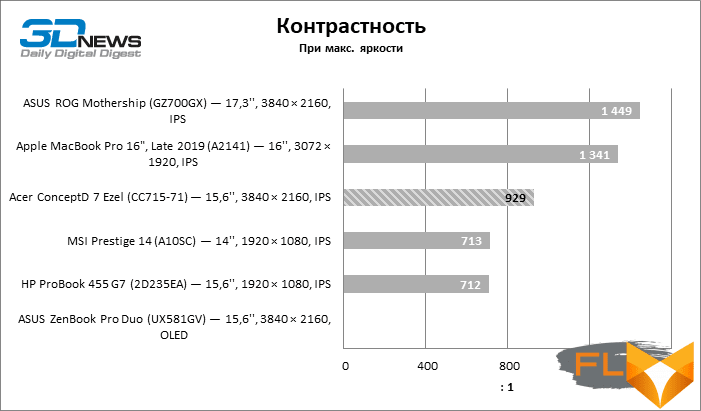
But the main thing is that the screen is calibrated and is accompanied by an ICC profile installed in the system. This was done by no means for show. Of course, only programs with their own color correction system can use a profile that describes display parameters. There is no end-to-end CMS in the Windows environment, and since we have a matrix with an extended color gamut of about 96.5% Adobe RGB, ordinary content designed for the sRGB palette looks oversaturated on it. Judging by the screenshots on the manufacturer’s website, the pre-installed ConeptD Palette software makes it possible to narrow the color gamut to the sRGB borders in order to eliminate oversaturation. We did not find such a setting, but this may be a feature of the test sample of the laptop, which is pre-production.
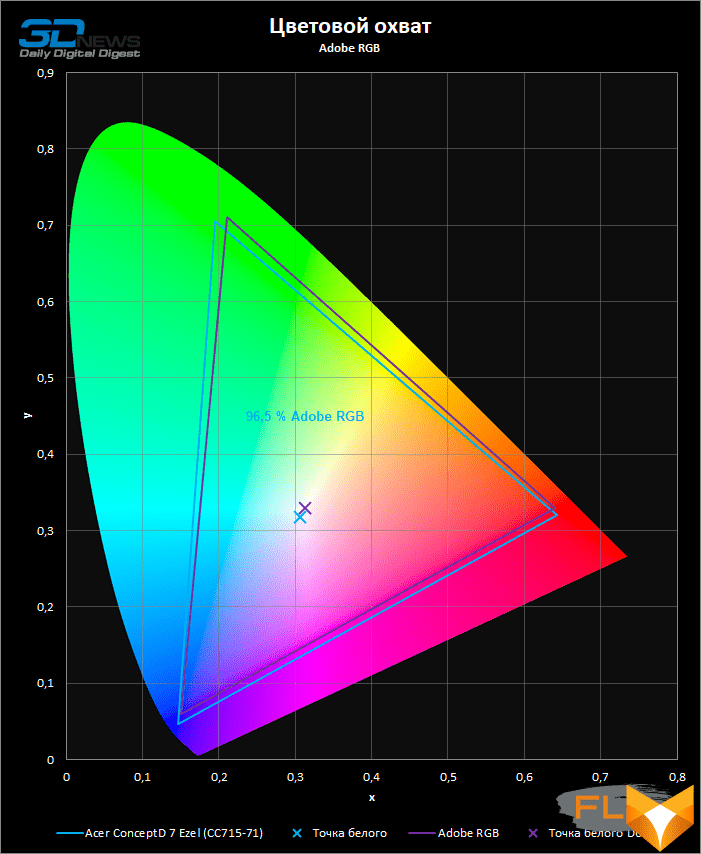
However, the calibration has a positive effect on the color temperature of the image, which is flattened at 7000K – this is still not the standard 6500K, but judging by the outstanding results of the rest of the tests, the color temperature is slightly increased on purpose, with the intention of maintaining a reserve of brightness.
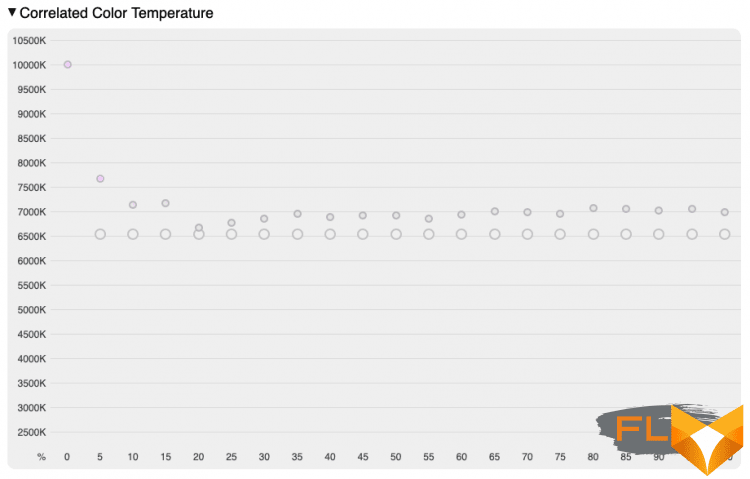
So, the gamma correction curve was adjusted quite accurately to the value of the power function of 2.2, and the curves of the basic colors also converge well.
 | 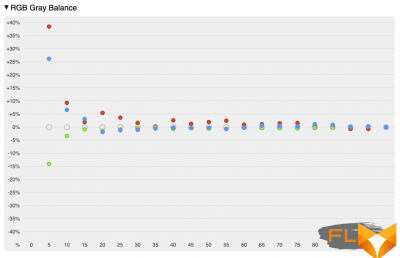 |
Fine-tuning resulted in perhaps the best hue fidelity we’ve seen on a laptop screen, with an average deviation of 1.2 in Delta E 2000 (corrected for white balance), meaning color error is in most cases undetectable to the naked eye. .
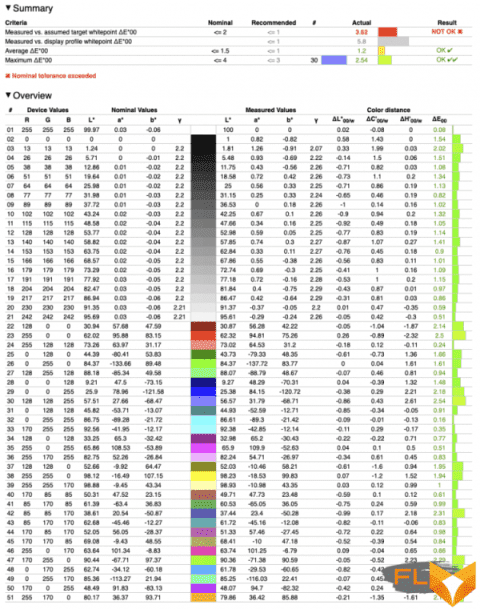
The ConceptD 7 Ezel’s factory screen calibration can be disabled in the ConceptD Palette utility. Then the original color gamut and brightness of the matrix will be revealed, and the user will be able to perform self-calibration and profiling, which, for sure, will be done by laptop buyers who intend to process visual content at a professional level. But most importantly, the ConceptD 7 Ezel screen is already very well tuned and, of course, is devoid of gross image defects associated with pronounced backlight unevenness or flickering at low brightness levels. The only thing you need to pay attention to is a slight “hoarfrost” of the anti-reflective coating, but the crystalline effect is weakly expressed and even pleasing to the eye.
⇡#Clock speeds, temperature and noise levels
The ConceptD 7 Ezel is built on Intel’s well-studied Comet Lake platform. However, unlike thin ultrabooks that are equipped with U-grade silicon, we are dealing with a full-blooded Comet Lake-H chip, which has a nominal power reserve of 35 W and allows factory overclocking up to 45 W, which Acer took advantage of. Thanks to the increased TDP, the six-core Core i7-10750H runs at an average clock speed of around 3.3 GHz at the highest load possible in real-world applications.
But when it comes to power efficiency advantages over the 9000-series chips, which were also widely used in powerful gaming and professional laptops, you should not expect miracles from Comet Lake. Intel still uses the time-honored 14nm process, which is said to be as dense as the 10nm lines of independent contractors in transistor density, but is already falling short of TSMC’s 7nm. Ryzen 4000 mobile chips are an obvious spoiler for Comet Lake, because even in the budget laptop HP ProBook 455 G7, the six-core Ryzen 5 4500U reaches frequencies of 3 GHz and at the same time consumes only 13 watts of power, but we already voiced the reasons for choosing Intel in the introductory parts of the review. The ConceptD 7 Ezel does not have alternative operating modes that shift the balance in favor of CPU performance, component temperature or cooling fan speed.
| Load Clock | ||||||||
|---|---|---|---|---|---|---|---|---|
| Cinebench R20 (Max Thread #) | LuxMark 3.1 | Cinebench R20 (Max Thread #) + LuxMark 3.1 | ||||||
| CPU clock speed, MHz | GPU clock speed, MHz | CPU clock speed, MHz | GPU clock speed, MHz | |||||
| Medium | Max | Medium | Max | Medium | Max | Medium | Max | |
| ConceptD 7 Ezel (CC715-71) – Intel Core i7-10750H / NVIDIA GeForce RTX 2070 Max-Q</td > | 3324 | 4174 | 1245 | 1305 | 2749 | 3858 | 1239 | 1320 |
| CPU and GPU power | ||||||||
|---|---|---|---|---|---|---|---|---|
| Cinebench R20 (Max Thread #) | LuxMark 3.1 | Cinebench R20 (Max Thread #) + LuxMark 3.1 | ||||||
| CPU power consumption, W | GPU power consumption, W | CPU power consumption, W | GPU power consumption, W | |||||
| Medium | Max | Medium | Max | Medium | Max | Medium | Max | |
| ConceptD 7 Ezel (CC715-71) — Intel Core i7-10750H / NVIDIA GeForce RTX 2070 Max-Q | 44 | 45 | 80 | 82 | 45 | 45 | 80 | 84 |
Прим. The measurement is performed after the device has warmed up and all parameters have stabilized.
Our copy of the laptop uses discrete GeForce RTX 2070 graphics in the Max-Q thermal package, and among the two options for the video adapter (designed for 80 or 90 W), Acer chose the younger model. In intensive work, the GPU develops clock frequencies typical for this accelerator of about 1245 MHz. However, it is still a very demanding and hot GPU that limits the potential of the (again, not the most energy efficient) CPU when both chips are loaded at the same time. As usual, the laptop automation does not try to reduce the power consumption of the discrete graphics core in order to support the CPU, but thanks to a high-quality cooling system, the stable CPU frequencies did not sink below 2.75 GHz.
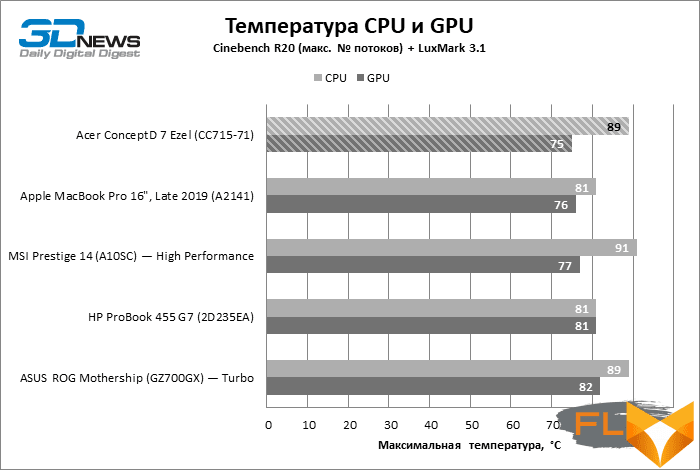
The ConceptD 7 Ezel cooler is really very good. It handles a fully loaded CPU effortlessly, keeping the chip temperature within 70°C, while being virtually inaudible in the living room. Even with intensive GPU computing, it cannot be said that the machine is too loud. The manufacturer’s statement that the noise level of the cooling system is within 40 dBA did not differ much from our measurements, and the difference can be attributed to the costs of the measurement technique. In any case, workstations with discrete graphics in a thinner chassis make a lot more noise.
As for the temperature of the main components, even if the CPU reaches 89 ° C under a combined load, this is an undesirable, but formally acceptable result for modern mobile processors. The laptop topcase is well isolated from the cooling system and does not warm up to an uncomfortable temperature even during intensive work.
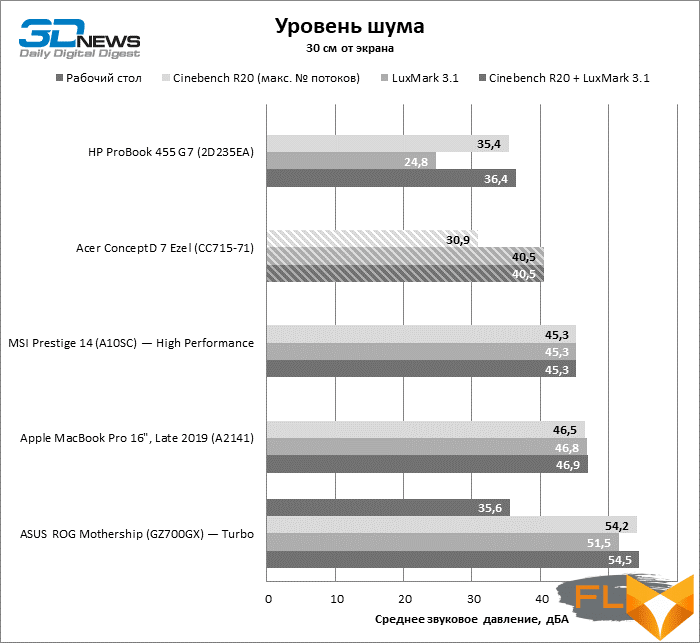
⇡#Synthetic benchmarks
The obvious conclusion that the data of processor benchmarks pushes is that the number of CPU cores in well-paralleled tasks is crucial. The laptops with eight-core Intel chips and the Ryzen 7 4800H have more computing power than the ConceptD 7 Ezel test sample. At the same time, the Acer laptop’s processor holds up well against the power-constrained octa-core found in the MacBook Pro and far outperforms the low-wattage Ice Lake and Ryzen 4000 chips.
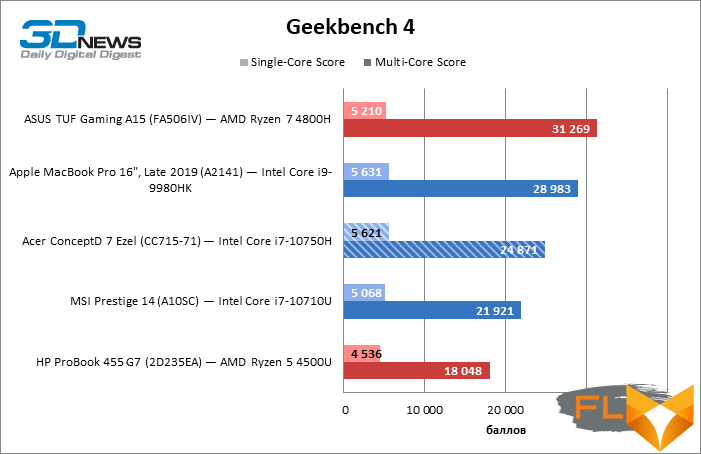
As for the GeForce RTX 2070 discrete graphics in the Max-Q thermal package, synthetic tests put it on a par with the GeForce RTX 2060 accelerator without the Max-Q mark, which is not surprising, given the close power consumption values of the two NVIDIA models. However, let’s not forget that the RTX 3070 has 2 GB more local memory, which is much more important in production applications.
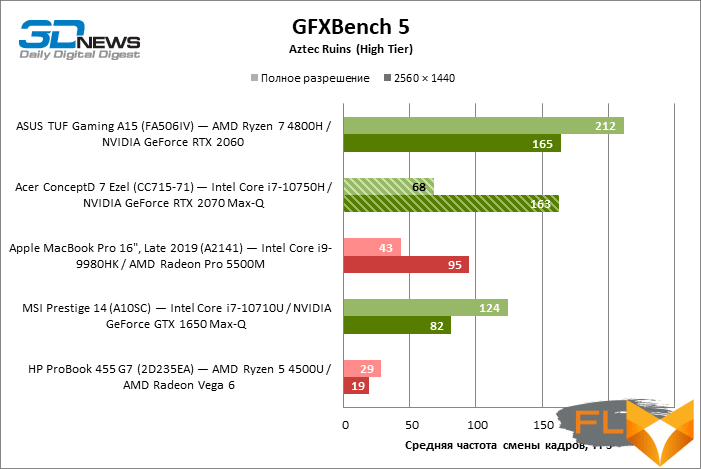
⇡#Performance in production applications
Using Blender rendering as a CPU benchmark, the results reproduce the picture we’ve already seen in synthetic benchmarks: the Core i7-10750H chip inside the ConceptD 7 Ezel is catching up to Intel’s octa-core compact workstations like the MacBook Pro and leaving blue and “Red” varieties of low-wattage six-core CPUs. However, this laptop has pretty powerful discrete graphics, and again, synthetics have already predicted the result in real applications: there is no significant difference in performance between the GeForce RTX 2070 Max-Q and RTX 2060. In any case, any GeForce RTX brand video card can significantly reduce rendering time by ray tracing with specialized GPU units through the OptiX API, which is compatible with the Cycles renderer. A similar picture is observed in the test using the Radeon ProRender engine, only “green” GPUs cannot use hardware ray tracing in it.
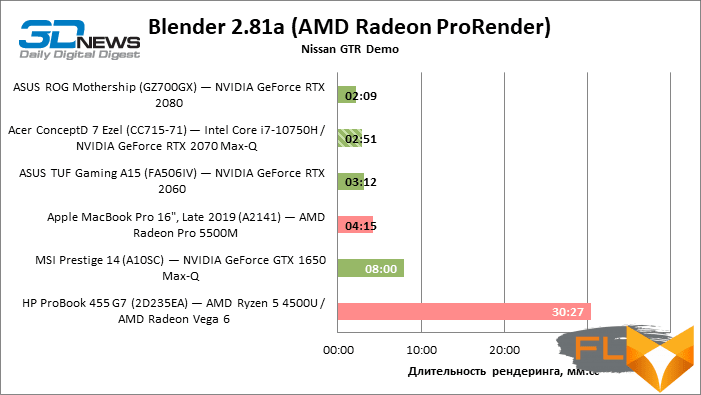
The Core i7-10750H and GeForce RTX 2070 Max-Q are a great Lightroom combo that outperforms the 16-inch MacBook Pro with higher CPU clocks and more powerful discrete graphics. However, the Lightroom benchmark causes a load mainly on the CPU, so the eight-core Ryzen 4000-series is out of competition here.
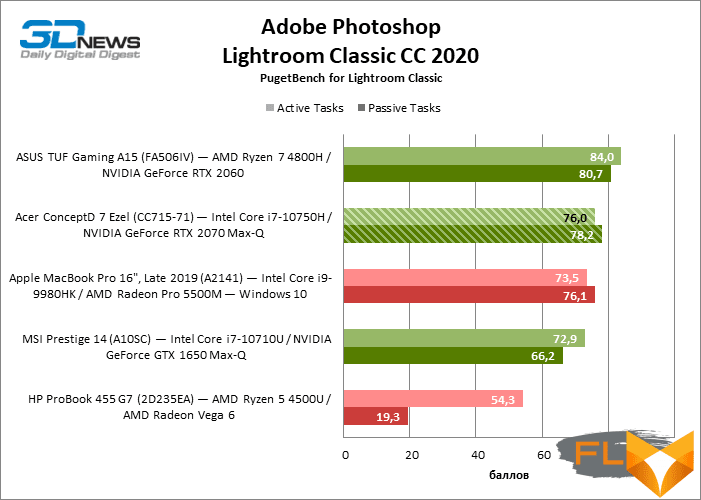
Note Scores are calculated as a percentage of Intel Reference Workstation performance Core i9-9900K, NVIDIA GeForce RTX 2080, 64GB RAM.
A test package for Photoshop brought similar results. Here, the ConceptD 7 Ezel acts as an analogue of the MacBook Pro, but it should be noted that any applications that can use the Metal API work faster under macOS. In addition, Photoshop is no longer a suitable workload to fully show the difference between today’s high-end laptops. Benchmarks of resource-intensive video editing and encoding applications perform this role much better.
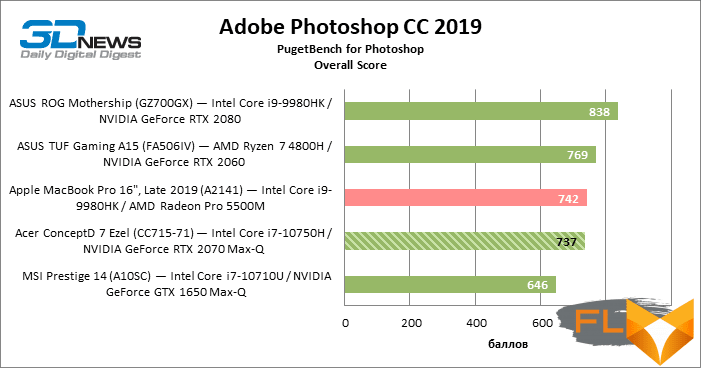
Note Scores are calculated as a percentage of Intel Reference Workstation performance Core i9-9900K, NVIDIA GeForce RTX 2080 and 64GB RAM x 10.
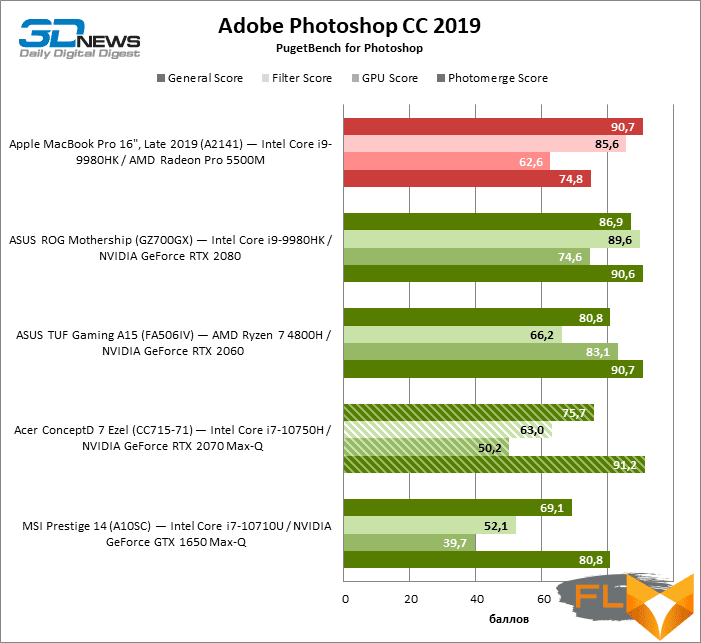
Note Scores are calculated as a percentage of Intel Reference Workstation performance Core i9-9900K, NVIDIA GeForce RTX 2080, 64GB RAM.
With 16GB of RAM and some serious discrete graphics, our ConceptD 7 Ezel sample passed through the Premiere Pro battery of tests and scored an integrated performance score. As expected, the Acer laptop is inferior to its octa-core counterparts in terms of live effects playback in the viewport, but thanks to a powerful GPU with 8 GB of RAM, it achieved good results in project export speed.
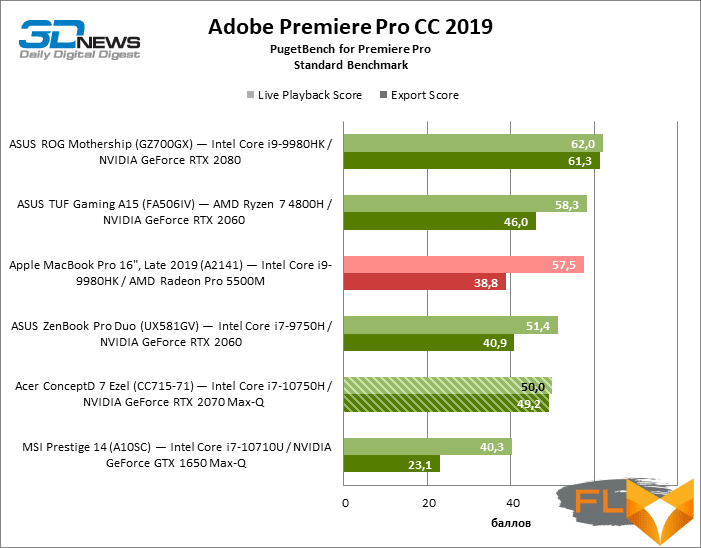
Note Scores are calculated as a percentage of the frame rate of the source or target format (for example, playing a video at full frame rate is worth 100 points). Unlike playback, when rendering video, the frame rate can exceed the target, which means the score will be higher than 100.
The advantage of a large number of processor cores is expressed in the frame rate of the viewing window when editing 4K video, burdened with complex effects. When performance is limited by the CPU, the Core i7-10750H does not guarantee smooth playback even at ½ of the original resolution. Fortunately, this is an extreme case, and assuming the lion’s share of the load falls on the graphics card, ConceptD 7 Ezel achieves an average frame rate of about 50 FPS. By the way, if in ray tracing the “red” Radeon Pro 5500M accelerator on the MacBook Pro board is not too much inferior to formally more productive “green” GPUs (of course, if we exclude rendering under the OptiX API), then Premiere Pro is known for its sympathy for NVIDIA accelerators. As a result, the MacBook Pro is far from the best choice for working in this video editor, which cannot be said about the ConceptD 7 Ezel.
 |  |
When it comes to exporting effects projects that are predominantly CPU-intensive, the Core i7-10750H is no match for an octa-core CPU, but outperforms the hexa-cores found in other laptops in terms of encoding speed. But video encoding with overlay effects that load the graphics core, ConceptD 7 Ezel performed faster than laptops based on the GeForce RTX 2060 and, moreover, discrete video adapters of a lower class.
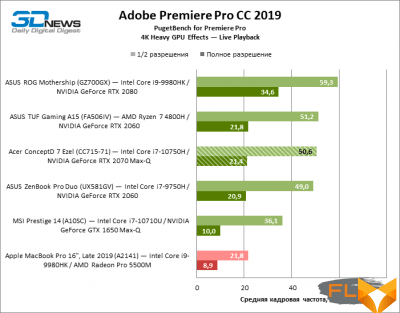 | 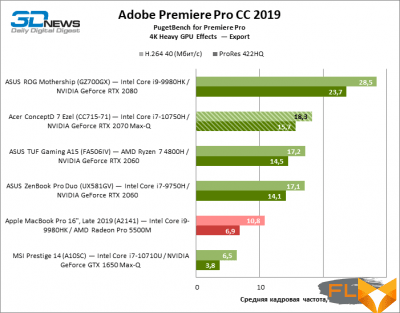 |
The Acer laptop excelled in the Adobe After Effects benchmark, only surpassed by the ASUS ROG Mothership, which is more of a portable candy bar than a truly mobile computer.

Note Scores are calculated as a percentage of Intel Reference Workstation performance Core i9-9900K, NVIDIA GeForce RTX 2080, 64GB RAM.
DaVinci Resolve brought similar results, but if we take a closer look at the performance in the common ProRes 422 codec, the ConceptD 7 Ezel imposes most of the effects faster compared to a laptop with an eight-core Ryzen processor, but in other situations, additional CPU cores are crucial. Since the Puget Systems benchmark for DaVinci Resolve can’t calculate the overall hardware score under macOS, we’re also forced to focus on ProRes 422 results to compare the ConceptD 7 Ezel to one of its main rivals, the 16-inch MacBook Pro. As you might expect, powerful discrete graphics are out of competition here, despite the fact that the eight-core CPU potential of the MacBook is higher.
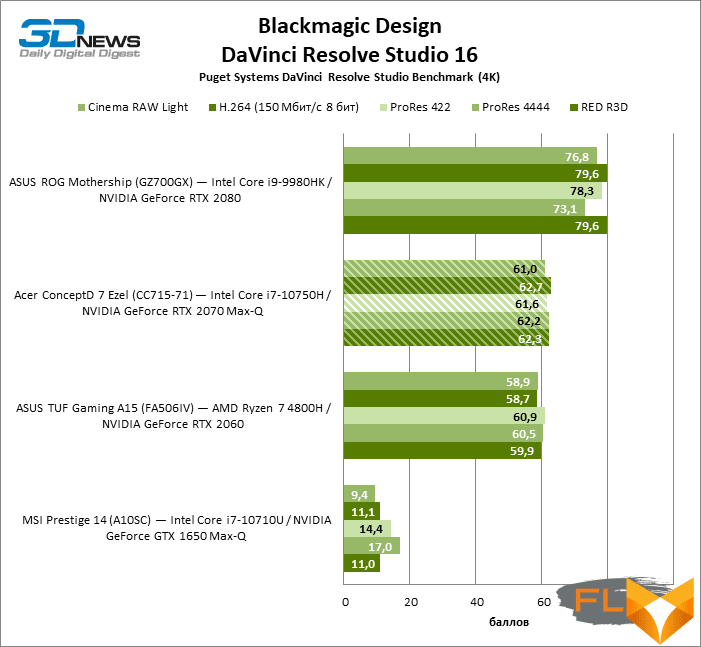
Note Scores are calculated as a percentage of Intel Reference Workstation performance Core i9-9900K and NVIDIA TITAN RTX.
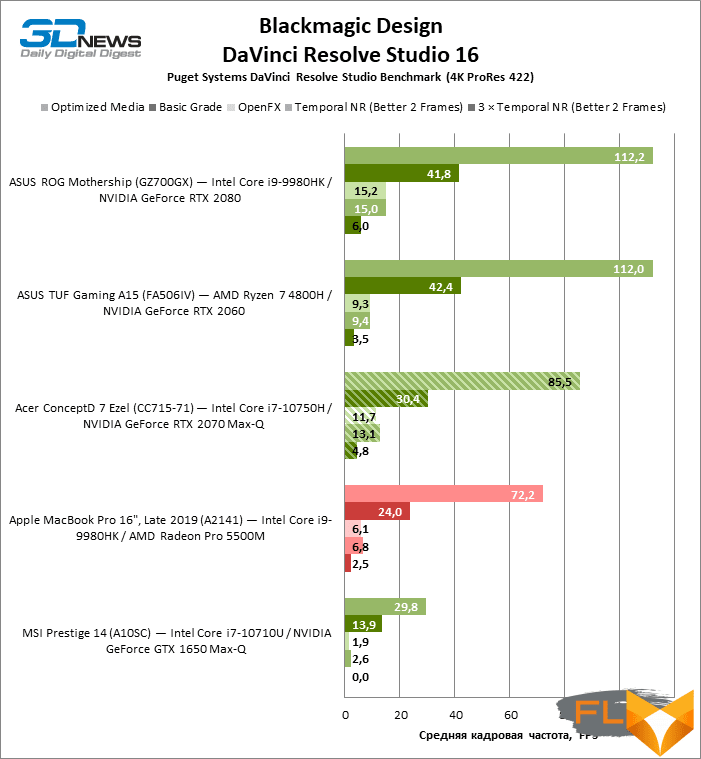
Fusion features are a relatively recent addition to DaVinci Resolve that are not well optimized for GPUs and place most of the processing load on the x86 cores. Not surprisingly, the laptops in the corresponding benchmark were sorted in order of CPU speed. Here, as in previous tests of this nature, the ConceptD 7 Ezel occupies an intermediate position between eight-core laptops and desktops, on the one hand, and thin six-core workstations, on the other.
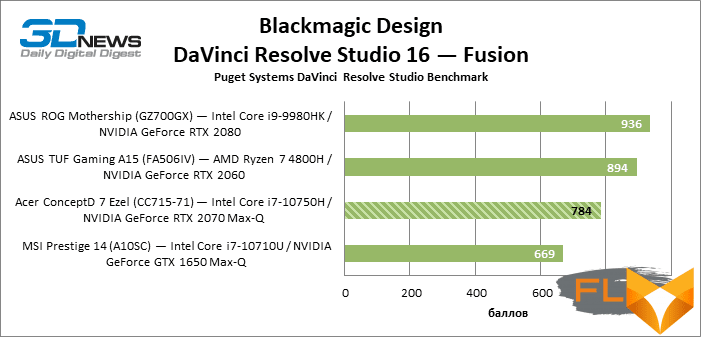
Note Scores are calculated as a percentage of the performance of a reference workstation based on Intel Core i9-9900K and NVIDIA TITAN RTX multiplied by 10.
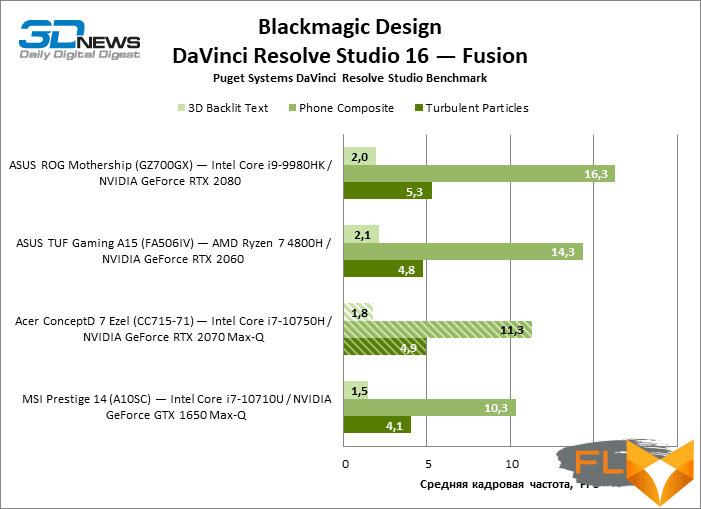
Note Scores are calculated as a percentage of the performance of a reference workstation based on Intel Core i9-9900K and NVIDIA TITAN RTX.
Finally, let’s pay attention to the results of the only test that intensively uses the tensor cores of NVIDIA GPUs to debayer video recordings in the RED R3D format. This benchmark again equated the GeForce RTX 2070 Max-Q with the mobile GeForce RTX 2060, but the performance of the older model is still higher. In addition, let’s focus on the fact that this task does not bypass the central processor: powerful graphics are most important for decoding source files in 6K and 8K, but in working with 4K ConceptD 7 Ezel is inferior to counterparts equipped with more powerful CPUs.

⇡#SSD Performance
What’s special about our ConceptD 7 Ezel configuration is that the laptop is equipped with two Samsung PM981a SSDs combined in zero RAID. And in order to appreciate the increase in ROM bandwidth that the array provides, we expanded the context of the study to include several machines that do not participate in other performance tests, but represent SSDs on various controllers that are on the market for mobile PC components.
As can be seen from the diagrams, the main advantages of RAID 0 are concentrated in the speed of linear reading and writing of large blocks, not only with an extremely long, but also with a short command queue typical for desktop tasks. This picture perfectly matches the nature of the accesses to the ROM by video and photo processing applications during the export of projects.
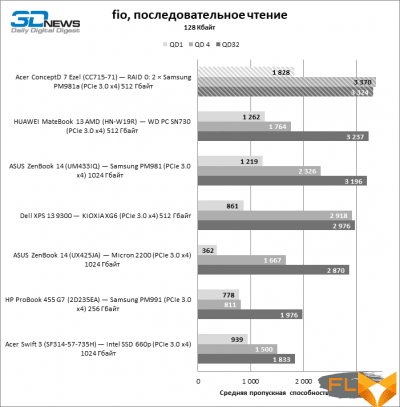 | 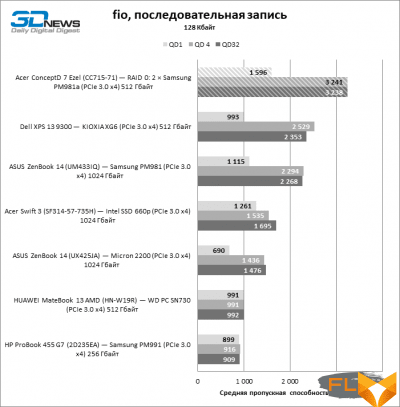 |
In terms of random access, the benefits of an SSD array come down to increased throughput when reading blocks with a long command queue, while when writing, on the contrary, it causes an overall performance penalty compared to a single 1TB Samsung PM981 drive.
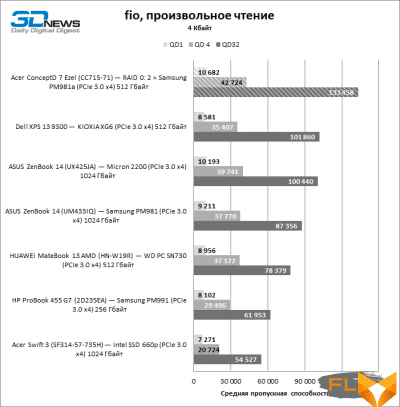 |  |
⇡#Battery Life
There is nothing in the ConceptD 7 Ezel to ensure that the laptop can work for a long time away from the outlet. Acer’s laptop has power-hungry components, including a serious discrete GPU, and the 4K display needs a high-powered backlight in order to develop a comfortable brightness level for work. Yes, and in terms of battery capacity of 84 Wh, we are far from a record holder. Nevertheless, the laptop managed to last more than 6 hours of active web surfing or almost 6 hours of video viewing on a single charge, and this is an excellent result in the class of mobile workstations.
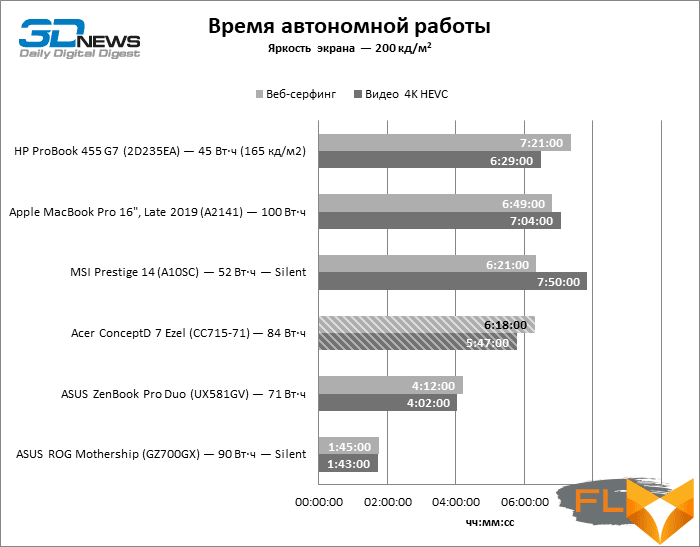
⇡#Conclusions
What a pleasure it is to work with professional equipment in rare intervals between reviews of computers for mere mortals! Acer’s ConceptD 7 Ezel mobile workstation is on a completely different level compared to the vast majority of laptops that are made and sold these days. Of course, this car is very, very expensive – at least $ 4,300 for one of the cheapest trim levels, and this is far from the limit. But we will once again repeat the thesis that runs like a red thread through all reviews of business and professional cars: the price in this case means much less than it seems, and is by no means a guarantee of quality.
You can get stuffing similar in speed for a more modest amount of money. Especially now that AMD has democratized the market for six- and eight-core mobile CPUs. The ConceptD 7 Ezel doesn’t complain about performance across a wide range of workloads, but that doesn’t make it any different from a simple, above-average gaming laptop. As a result, it is unlikely that anyone in their right mind would buy this laptop with the expectation of gaming, and not for work. It is much more difficult to find a computer of equivalent processing power, only with an unconditionally high-quality screen (not to mention factory calibration) and, in addition, free from typical compromises in the design of the chassis and controls.
Indeed, the ConceptD 7 Ezel’s screen is great. There are plenty of laptops with 4K matrices on the market, but we have seen such color quality out of the box, perhaps, only in the 16-inch MacBook Pro (and what the MacBook does not have is a tablet mode and a Wacom pen-enabled digitizer) . Add to this a well-built case, a comfortable keyboard and touchpad (the latter, however, is small for the dimensions of the machine), as well as an abundance of external interfaces, including wired Ethernet, a full-size card reader and DisplayPort. The novelty pleasantly surprised even the battery life, although we certainly did not count on this. Of course, all these features in a laptop for professionals are taken for granted, and the Acer laptop has worthy rivals in its field, but if the choice fell on the ConceptD 7 Ezel, the buyer is unlikely to find a reason to be disappointed.
